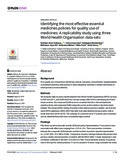| dc.contributor.author | Holloway, Kathleen | |
| dc.contributor.author | Ivanovska, Verica | |
| dc.contributor.author | Manikandan, Solaiappan | |
| dc.contributor.author | Jayanthi, Mathaiyan | |
| dc.contributor.author | Mohan, Anbarasan | |
| dc.contributor.author | Forte, Gilles | |
| dc.contributor.author | Henry, David | |
| dc.date.accessioned | 2020-02-21T14:44:57Z | |
| dc.date.available | 2020-02-21T14:44:57Z | |
| dc.date.issued | 2020-02-06 | |
| dc.identifier.citation | Holloway, K.A.; Ivanovska, V.; Manikandan, S.; Jayanthi, M.; Mohan, A.; Forte, G. and Henry, D. (2020) Identifying the Most Effective Essential Medicines Policies for Quality use of Medicines: A Replicability Study Using Three World Health Organisation Data-sets. PLoS ONE 15(2): e0228201.https://doi.org/ 10.1371/journal.pone.0228201 | en |
| dc.identifier.uri | https://opendocs.ids.ac.uk/opendocs/handle/20.500.12413/15128 | |
| dc.description.abstract | Suboptimal (irrational, incorrect, inappropriate) use of medicines is widespread, wasteful, and causes poor patient outcomes including anti-microbial drug resistance [1–9]. Interventions to improve quality use of medicines (QUM) in low/middle-income countries have mostly been small-scale, of limited duration, with small to modest effects [10–11]. Evidence from studies that we conducted in public healthcare sectors in developing and transitional countries suggests that implementation of WHO essential medicines (EM) policies is associated with better quality use (rational use) of medicines (QUM), including more appropriate use of anti-microbial agents [12–14]. The original WHO global data-set [12] covered the period 2003–2007 and there was uncertainty about how well EM policies were executed (based on country self-reports), with simultaneous deployment of multiple policies making it difficult to estimate individual impacts. We accessed a second source of data collected during 2-week visits to countries in South-East Asia during 2010–15, where policy implementation was observed independently [14]. The analyses of these data confirmed several of the findings of the earlier studies [12–13], including a correlation between the total numbers of EM policies implemented and composite measures of QUM. However, it remains unclear which policies are associated with the largest beneficial effects on medicines use. The aims of the present work were to analyse an updated global WHO data-set (2007– 2011), which included some policies not previously evaluated, and to test the consistency of our earlier findings of an increased impact with larger numbers of implemented EM policies. In addition, we wished to assess replicability of findings by correlating the rankings of policies that were common to the three studies to determine whether certain policies were consistently associated with the largest effects. | en |
| dc.language.iso | en | en |
| dc.publisher | PLOS ONE | en |
| dc.rights.uri | http://creativecommons.org/licenses/by/4.0/ | en |
| dc.subject | Health | en |
| dc.title | Identifying the Most Effective Essential Medicines Policies for Quality use of Medicines: A Replicability Study Using Three World Health Organisation Data-sets | en |
| dc.type | Article | en |
| dc.rights.holder | Copyright: ©2020 Holloway et al. | en |
| dc.identifier.doi | https://doi.org/10.1371/journal.pone.0228201 | |
| rioxxterms.funder | Default funder | en |
| rioxxterms.identifier.project | Default project | en |
| rioxxterms.version | NA | en |
| rioxxterms.funder.project | 9ce4e4dc-26e9-4d78-96e9-15e4dcac0642 | en |


